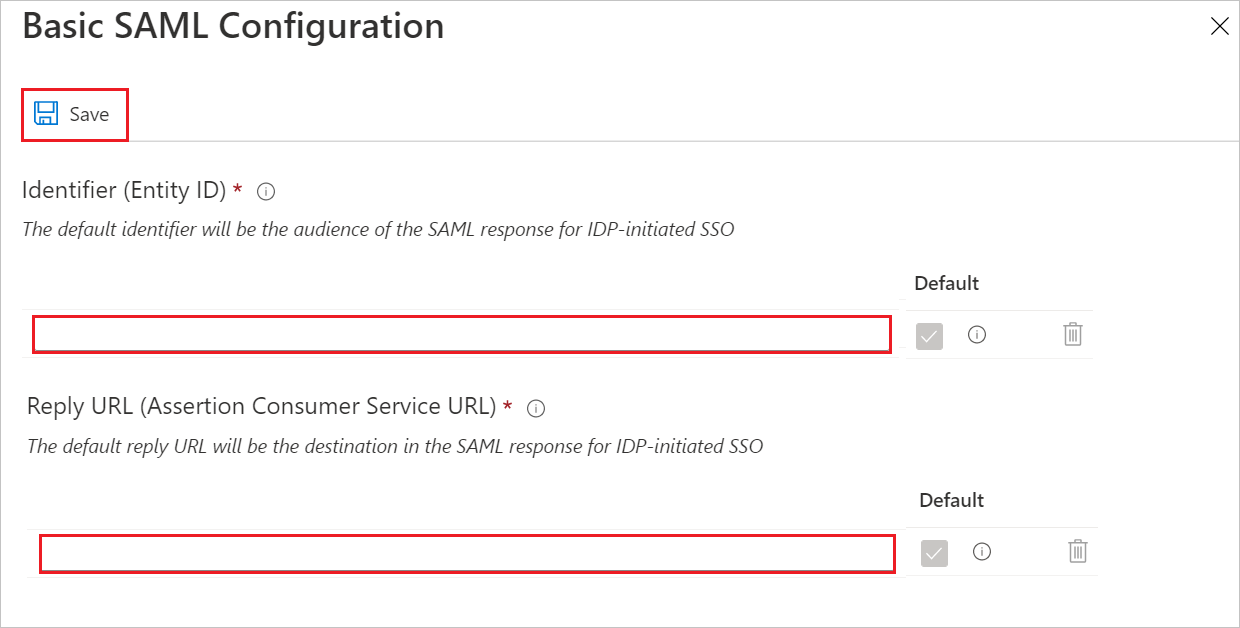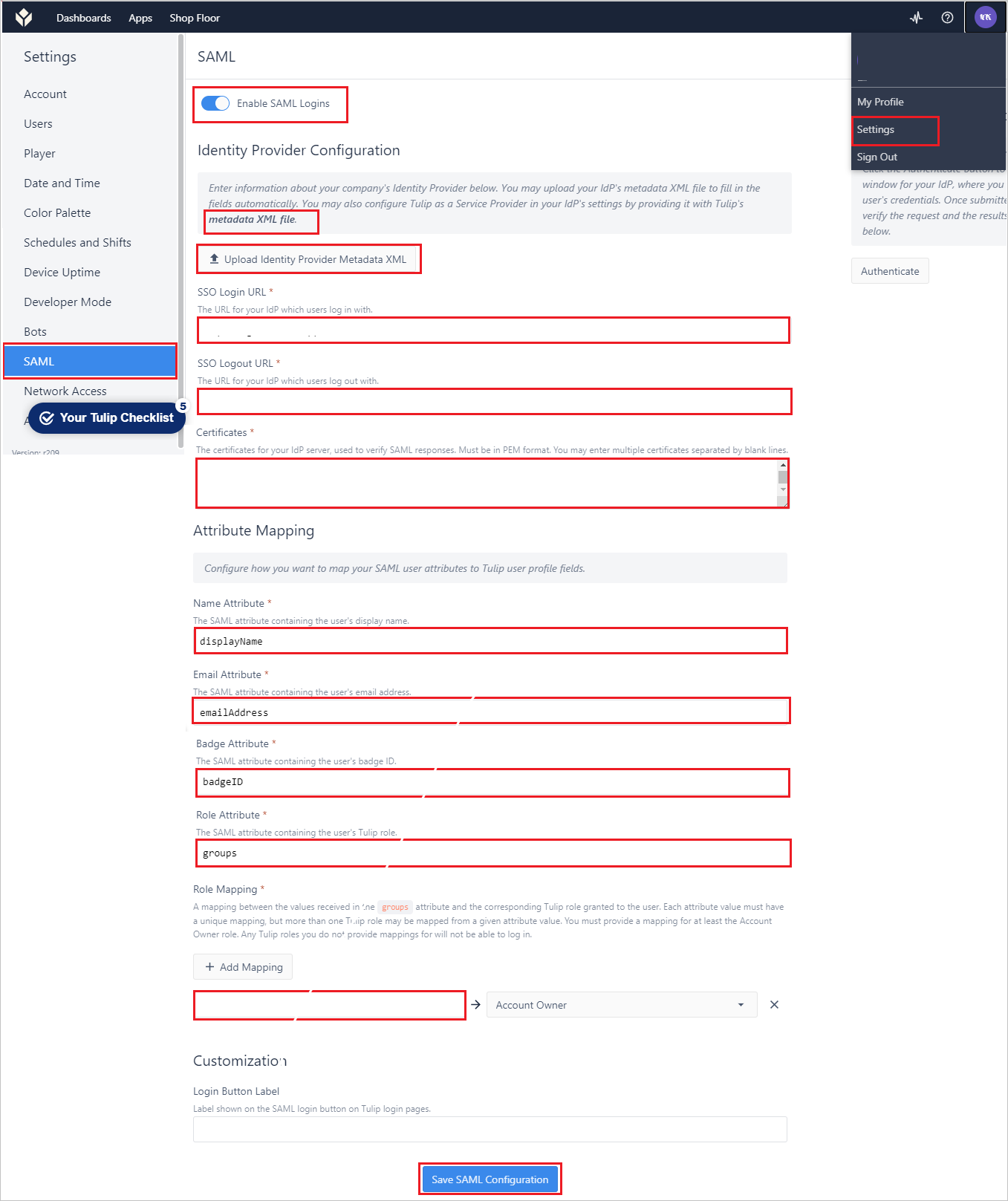Microsoft Entra SSO integration with Tulip
In this article, you'll learn how to integrate Tulip with Microsoft Entra ID. When you integrate Tulip with Microsoft Entra ID, you can:
- Control in Microsoft Entra ID who has access to Tulip.
- Enable your users to be automatically signed-in to Tulip with their Microsoft Entra accounts.
- Manage your accounts in one central location.
Prerequisites
To get started, you need the following items:
- A Microsoft Entra subscription. If you don't have a subscription, you can get a free account.
- Tulip single sign-on (SSO) enabled subscription.
Note
This integration is also available to use from Microsoft Entra US Government Cloud environment. You can find this application in the Microsoft Entra US Government Cloud Application Gallery and configure it in the same way as you do from public cloud.
Scenario description
In this article, you configure and test Microsoft Entra SSO in a test environment.
- Tulip supports IDP initiated SSO.
Add Tulip from the gallery
To configure the integration of Tulip into Microsoft Entra ID, you need to add Tulip from the gallery to your list of managed SaaS apps.
- Sign in to the Microsoft Entra admin center as at least a Cloud Application Administrator.
- Browse to Identity > Applications > Enterprise applications > New application.
- In the Add from the gallery section, type Tulip in the search box.
- Select Tulip from results panel and then add the app. Wait a few seconds while the app is added to your tenant.
Alternatively, you can also use the Enterprise App Configuration Wizard. In this wizard, you can add an application to your tenant, add users/groups to the app, assign roles, as well as walk through the SSO configuration as well. Learn more about Microsoft 365 wizards.
Configure and test Microsoft Entra SSO for Tulip
To configure and test Microsoft Entra SSO with Tulip, perform the following steps:
Configure Microsoft Entra SSO - to enable your users to use this feature.
Configure Tulip SSO - to configure the single sign-on settings on application side.
- To configure SSO on a Tulip instance with existing users, reach out to support@tulip.co.
Configure Microsoft Entra SSO
Follow these steps to enable Microsoft Entra SSO.
Sign in to the Microsoft Entra admin center as at least a Cloud Application Administrator.
Browse to Identity > Applications > Enterprise applications > Tulip > Single sign-on.
On the Select a single sign-on method page, select SAML.
On the Set up single sign-on with SAML page, click the pencil icon for Basic SAML Configuration to edit the settings.

On the Basic SAML Configuration section, if you have Service Provider metadata file, perform the following steps:
a.Download Tulip's Metadata File which is accessible under the settings page on your Tulip instance -
b. Click Upload metadata file.

b. Click on folder logo to select the metadata file and click Upload.

c. Once the metadata file is successfully uploaded, the Identifier and Reply URL values get auto populated in Basic SAML Configuration section:

Note
If the Identifier and Reply URL values are not getting auto populated, then fill in the values manually according to your requirement.
Tulip application expects the SAML assertions in a specific format, which requires you to add custom attribute mappings to your SAML token attributes configuration. The following screenshot shows the list of default attributes. If the
nameIDneeds to be an email, change the format to bePersistent.
In addition to the above, Tulip application expects few more attributes to be passed back in SAML response which are shown below. These attributes are also pre populated but you can review them as per your requirements.
Name Source Attribute displayName user.displayname emailAddress user.mail badgeID user.employeeid groups user.groups On the Set up single sign-on with SAML page, in the SAML Signing Certificate section, find Federation Metadata XML and select Download to download the certificate and save it on your computer.
Configure Tulip SSO
Log in to your Tulip instance as an Account Owner.
Go to the Settings -> SAML and perform the following steps in the below page.

a. Enable SAML Logins.
b. Click on metadata xml file to download the Service Provider metadata file and use this file to upload in the Basic SAML Configuration section in Azure portal.
c. Upload the Federation Metadata XML file from Azure to Tulip. This will populate the SSO Login, SSO Logout URL and the Certificates.
d. Verify that the Name, Email and Badge attributes are not null, that is, enter any unique strings in all three inputs and do a test authentication using the
Authenticatebutton on the right.e. Upon successful authentication, copy/paste the entire claim URL into the appropriate mapping for the name, email and badgeID attributes.
Paste the Name Attribute value as
http://schemas.microsoft.com/identity/claims/displaynameor the appropriate claim URL.Paste the Email Attribute value as
http://schemas.xmlsoap.org/ws/2005/05/identity/claims/nameor the appropriate claim URL.Paste the Badge Attribute value as
http://schemas.xmlsoap.org/ws/2005/05/identity/claims/badgeIDor the appropriate claim URL.Paste the Role Attribute value as
http://schemas.xmlsoap.org/ws/2005/05/identity/claims/groupsor the appropriate claim URL.
f. Click Save SAML Configuration.
Related content
Once you configure Tulip you can enforce session control, which protects exfiltration and infiltration of your organization’s sensitive data in real time. Session control extends from Conditional Access. Learn how to enforce session control with Microsoft Defender for Cloud Apps.
Please reach out to support@tulip.co for any further questions including migrating existing users in Tulip to use SAML!